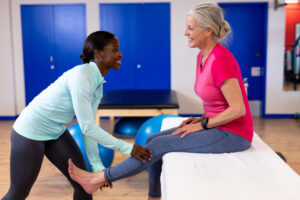In today’s fast-paced world, our lives are so busy that we often ignore everyday nagging pains. Whether your back, neck or knee is causing discomfort, turning a blind eye to the initial signs something is wrong could turn a small problem into a bigger issue.
Normally, we wait until an injury occurs before seeing a physical therapist, but there are many benefits of visiting Integrated Rehab for a risk assessment. To avoid potential injuries down the road, we’ll assess your “little pains” and teach you strategies to reduce risk of developing a larger problem.

Working with a PT
The human body is designed to move, yet we live in an automated world with too much sitting and not enough physical activity. As a result, we’re more susceptible to injury when we are active and more prone to conditions related to inactivity.
At your initial consultation, our physical therapists will help you understand the root cause of your pain. For instance, you may think lifting a heavy object has led to your back spasms, yet these common pains are often an accumulation of repetitive stress and postural changes.
As experts in biomechanics of the human body, physical therapists will teach you strategies that can relieve your everyday aches. A detailed home exercise program will support these strategies to promote better movement patterns. When these at-home exercises are skipped, the pain can worsen and you will end up back in our office.
The Problem with Posture
Many of our non-surgical patients have neck, back or shoulder pain directly related to postural issues. Exercises to improve posture are so important, especially when the average person spends nearly 3 hours a day on a smartphone! You could be an active individual who goes to the gym for an hour every morning but then sits at a desk for 8 hours, likely with poor postural habits.

Unfortunately, there is very little core muscle activation during the sitting most of us do throughout the day. If we do exercise, we all too often head to the gym and sit down once again to perform exercises.
Each day, we ALL push and pull, lift and carry, sit and stand to varying degrees. Our training program NEEDS to reflect these basic functional movements. Given the nature of our training, we should not be surprised when we suffer overuse and postural changes as a result of our relative inactivity. Let us help you make a change!
At the Integrated Rehab, we teach exercises for life. We focus on the two fundamentals of movement: Mobility and stability. Mobility is the ability to move our bodies in certain directions and stability is being able to lock the body down in place to function.
Our Physical Therapists, Certified Strength and Conditioning Specialists and Athletic Trainers have years of experience and know-how to maximize the body’s potential. You will work with these professionals to learn the right exercises that are safe but challenging for your level of function.
Bridge to Wellness
Your time with Integrated Rehab does not have to end after physical therapy treatment! We also encourage and teach people how to be more active in their everyday lives. However, you may be nervous to start a fitness regimen after an injury. To help our patients avoid sedentary living, we offer two training sessions to “bridge” them back to fitness after physical therapy. The individualized “Bridge to Wellness” sessions teach patients the do’s and don’ts of working out to safely challenge the body, based on their specific condition.
We also provide injury prevention tips to help our patients avoid future incidents. You may not realize it, but there are correct techniques for lifting, carrying, pushing and pulling activities related to fall and winter cleanup. As a general rule of thumb, we should avoid combined movements of bending and twisting. Mobility refers to your ability to get into a position while stability in the spine helps you lift.
Reaching Your Goals

When the ball drops at midnight on January 1st, do you vow to start a new health and wellness plan? While weight loss and regular exercise are common New Year’s resolutions, statistics show only 8 percent of people accomplish their goals. Approximately 75 percent of people abandon their resolution after just 30 days.
Our question to you is, why wait? When the calendar flips to a new year, we’re often in our worst physical state after the indulgent holiday season. The people who are truly motivated to better their health and start right now are more likely to attain healthy habits for life.
To learn more about our programs, contact us today!

